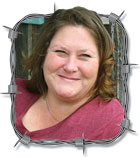Greg, like many of his childhood friends, grew up on a dairy farm in the middle of nowhere. Unfortunately for him, that “nowhere” became one of the fastest growing areas of the state and is now the lone farm in an area surrounded by million-dollar homes, a world-class golf course, strip malls and fast food restaurants. Greg moved away several years ago, about 45 miles west, to his own “middle-of-nowhere” farm, but his father stayed put. As the old man said, “I was here first and they can’t develop my farm ‘til they haul me away, feet first.”
Greg’s father has sold a few acres off the original place (when land goes for $20,000 to $30,000 an acre, who can blame him?), but he adamantly stays put. He has switched from milking to running beef cattle, but he keeps on with the tradition because he loves the life and… as Greg put it, “I think he really loves to aggravate the new neighbors.”
The father, many times, will put problems right out next to the road simply to goad passers-by into stopping. He seems to get a kick out of it, as with a couple years ago, when one of the mansion dwellers stopped to inquire about the fattest cow he had ever seen. So fat, in fact, that the curious neighbor even observed, “the cow looks like she might be miserable.”
“Well, partner,” Greg’s dad replied in his drawl, “That ‘cow’ is actually a steer and it ought to look miserable ‘cause it’s been bloated all day long. Would you like to buy it, cheap?”
Another time, someone heading to the golf course on a Saturday morning stopped to inquire about the “two-headed, six-legged cow” out by the road. She seemed disappointed when the elderly gentleman informed her that the cow was in the process of having a calf and the extra head and pair of feet were simply the first parts out. It’s obvious the farmer enjoys himself.
One thing he doesn’t enjoy in his “new” neighborhood, though, is getting rid of the occasional dead animal. In the old days, fresh dead livestock would be picked up by the rendering plant and less-than-fresh dead would be picked clean by scavengers in a mere day or two. The rendering plant shut down two years ago and the sprawling neighborhood has reduced the scavengers to the point where a rotting carcass brings the health department over immediately. He can’t burn the remains because of newly instituted community regulations. So now, he simply calls Greg when an animal dies, since his son still lives in the “free” part of the state.
A few weeks ago Greg got an urgent call from his aging father. His dad had lost a 600 lb. feeder calf during the night and he asked his son if he could come over before it started smelling and haul it back to his place to bury, burn or feed to the critters. Greg obliged and said he would be there in an hour or two.
Arriving at his old home farm, Greg and his dad drove out into the field and loaded the calf on the flat bed truck, using the front-end loader of the tractor. The calf had not been dead long and, according to Greg, “hadn’t even swelled up much, yet.” Greg carefully tied the cargo down to the flatbed using an assortment of chains and nylon straps. He pulled the truck seat forward to retrieve the blue tarp and cover the carcass for his 45 mile trip to the other farm when he realized he hadn’t put the tarp back in its place since using it for something else the week before. Oh, well, there surely wasn’t a law against transporting a dead calf uncovered.
As Greg turned out and headed for home, he glanced at his watch. 11:00 A.M. and he was hungry. He instantly decided to grab a quick lunch while he was still in a populated area. After ordering a burger, fries, and soft drink, he pulled forward to pay and pick up his food. As the attractive young lady handed him his food and drink, her eyes wandered to the bed of Greg’s truck. “Uggggh, what is THAT!” she screamed.
Calmly, Greg replied, “The same thing you just gave me in the sack, minus the bread, catsup, onions, and pickles. You want to trade even up?”
I think maybe someone else likes having a little fun out of the new neighbors, too.
Jerry Crownover farms in Lawrence County. He is a former professor of Agriculture Education at Missouri State University, and is an author and professional speaker. To contact Jerry, go to www.ozarksfn.com and click on 'Contact Us.'






